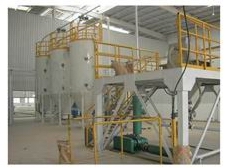
Working principle.
Positive pressure type: installed in the use of high pressure air conveying system starting point ( roots blower, pump, centrifugal fan ) the positive pressure air into rotary feeder device, material from the hopper to join, into the rotary feeder for the quantitative feeding under the action of gravity, material and the air through the pipeline to the end of the separator or storage, gas separation, air through the filter is discharged into the atmosphere.
Negative pressure type: the material from the hopper to join, into the rotary feeder for the quantitative feeding under the action of gravity, which is installed at the end of the high pressure fan delivery system ( roots blower, pump, centrifugal fan ) produced by the negative pressure, the material and the air through the pipeline to separator or storage, the material air separation, air through the filter is discharged into the atmosphere.
Characteristic.
#9830; with high pressure fan for air, rotary feeder for feeding device, continuous suction, pressure feeding material.
#9830; equipment has simple structure, stable and reliable, convenient maintenance, delivery pressure safety.
#9830; material in pipeline transport, time is very short, so as to realize the automation, the product does not contact with the outside world, small pollution, good quality, can meet the food, pharmaceutical and health requirements.
#9830; especially suitable for material from one point to multiple dispersing conveyor.
Sketch map.

technical parameters
|
型号 |
输送管径
(mm) |
输送压力
(kpa) |
输送量
(kg/h) |
输送高度
(m) |
输送距离
(m) |
风机功率
(kw) |
|
XQS-50 |
50 |
9.8-58.8 |
200-500 |
30 |
200 |
0.75-2.2 |
|
XQS-65 |
65 |
9.8-58.8 |
500-800 |
30 |
200 |
1.1-4 |
|
XQS-80 |
80 |
9.8-58.8 |
800-1200 |
30 |
200 |
1.5-5.5 |
|
XQS-100 |
100 |
9.8-58.8 |
1600-2700 |
30 |
200 |
3-11 |
|
XQS-125 |
125 |
9.8-78.4 |
2700-5400 |
30 |
200 |
4-30 |
|
XQS-150 |
150 |
9.8-78.4 |
5900-10000 |
30 |
200 |
10-55 |
|
XQS-200 |
200 |
9.8-78.4 |
7600-12000 |
30 |
200 |
15-75 |
Note: 1, air a Roots blower as an example.
2, the data in the table is the basic data, according to the physicochemical properties of material change. |